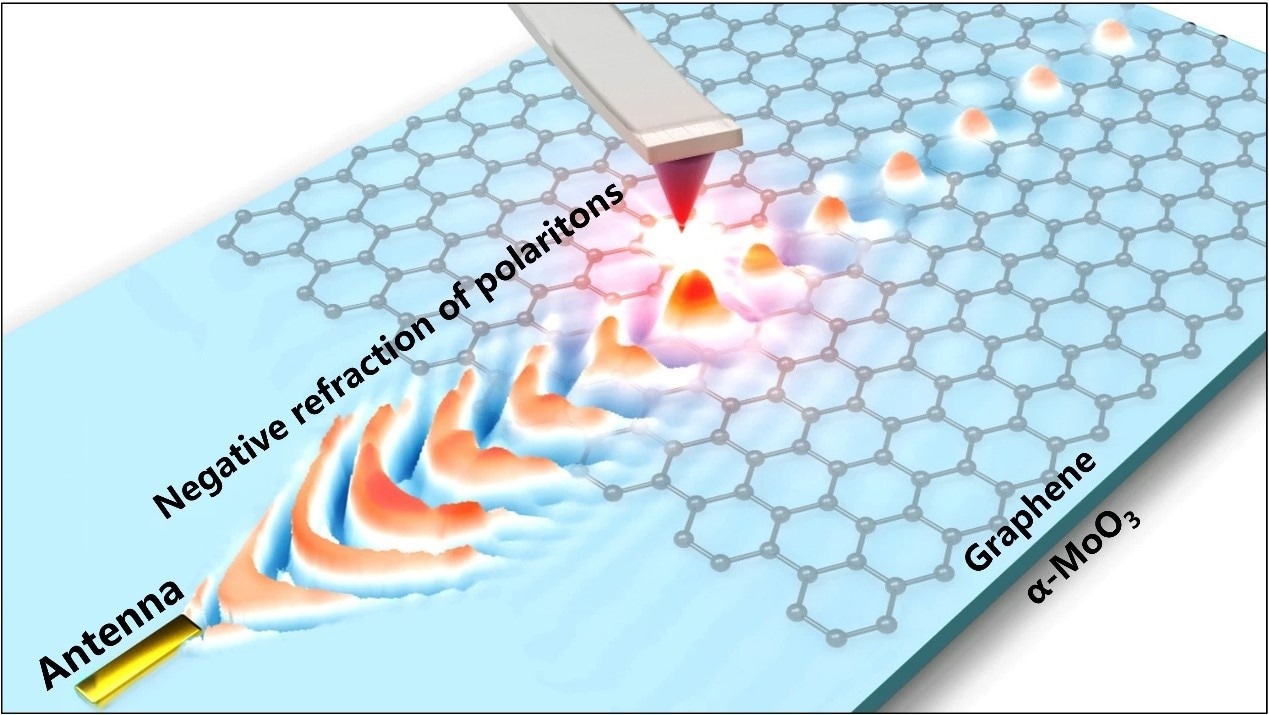A recent study led by Javier Abajo from the Institut de Ciencies Fotoniques (ICFO) and Qing Dai from the National Center for Nanoscience and Technology (NCNST) of the Chinese Academy of Sciences (CAS) demonstrated a gate-tunable nanoscale negative refraction of polaritons in the mid-infrared range through a van der Waals heterostructure of graphene and molybdenum trioxide.
 Basic principle of the “polariton transistor”. The van der Waals heterostructure is constructed by decorating graphene on the molybdenum trioxide, and the antenna stimulates the polariton to transmit through the interface to form negative refraction. Image Credit: Qing Dai et al.
Basic principle of the “polariton transistor”. The van der Waals heterostructure is constructed by decorating graphene on the molybdenum trioxide, and the antenna stimulates the polariton to transmit through the interface to form negative refraction. Image Credit: Qing Dai et al.
The atomically thick heterostructures reduce scattering losses at the interface while allowing electrical gating to actively control the transition from normal to negative refraction.
The findings were published in Science on February 10th. 2023.
Future high-performance information devices will benefit significantly from photonic-electronic fusion at the nanoscale. The optoelectronic interconnection technique, which determines the integration of optoelectronic devices and impacts their speed and power consumption, is essential for enhancing their performance.
However, unlike electrons, which can be easily controlled by electrical methods, photons cannot carry charges, and the transmission of light is constrained by the optical diffraction limit. This makes it challenging to manipulate and control photons at the nanoscale.
Through his renowned “Huang equation,” the Chinese Solid Physicist Academician Kun Huang foresaw the quasi-particle of polaritons that would result from the interaction of photons with matter in 1951.
The ability of polaritons to readily surpass the optical diffraction limit and compress the wavelength of light to the nanoscale has been demonstrated after years of research and ongoing in-depth discoveries. Its field distribution is also directly tied to the dielectric environment.
Polaritons were proposed as a medium for optoelectronic interconnections by the NCNST team, who used their high compression and simple manipulation of light.
Polaritons were expected to dramatically enhance the performance of optoelectronic fusion devices by enabling efficient optoelectronic interconnections and novel information processing capabilities.
The “axial dispersion” effect of polarized excitons in low-symmetry crystals was discovered by Dai’s team and collaborators in recent work (Nature Nanotechnology); the long-range transport problem of plasmonic in graphene was resolved (Nature Communications); and a new mechanism for the control of polaritons by heterojunctions was proposed (Nature Nanotechnology).
Based on this, the researchers created a van der Waals heterostructure of nanoscale graphene and molybdenum trioxide.
They outlined how the van der Waals heterostructure fully utilizes the nanophotonic properties of various materials, with the atomic layer thickness serving as the foundation for highly compressed optical modes, the lattice structure’s properties supporting isotropic (circular) and anisotropic (hyperbolic) transport modes, the van der Waals stacking satisfying the near-field matching of mode hybridization, and the linear energy band structure serving as a platform for mode hybridization
Additionally, the researchers achieved dynamically controllable positive-negative refractive transitions in the deep sub-diffraction limit and overcame the performance limitations of traditional structural optical approaches like the use of metamaterials and photonic crystals in terms of waveband, loss, compression, and modulation.
This dynamically tunable positive and negative refraction conversion phenomenon can be understood as a “polariton transistor” function that uses one kind of polariton to regulate the switching of another polariton, which allows the construction of optical logic units such as those with and without gates and is anticipated to be applied in many fields, such as photoelectric fusion.
Qing Dai, Study Corresponding Author and Professor, Material Science, National Center for Nanoscience and Technology, Chinese Academy of Sciences
Journal References:
Hu, H., et al. (2023) Gate-tunable negative refraction of mid-infrared polaritons. Science. doi:10.1126/science.adf1251
Hu, G., et al. (2022) Real-space nanoimaging of hyperbolic shear polaritons in a monoclinic crystal. Nature Nanotechnology. doi:10.1038/s41565-022-01264-4
Hu, H., et al. (2022) Active control of micrometer plasmon propagation in suspended graphene. Nature Communications. doi:10.1038/s41467-022-28786-8
Hu, H., et al. (2022) Doping-driven topological polaritons in graphene/α-MoO3 heterostructures. Nature Nanotechnology. doi:10.1038/s41565-022-01185-2